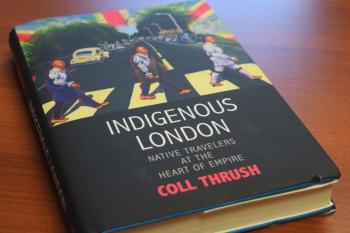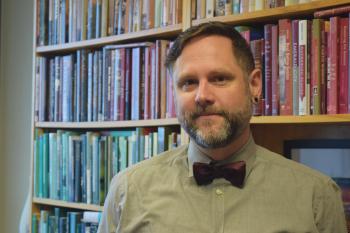When thinking of places to research North American Indigenous history, London, England may not immediately spring to mind.
But that's exactly what Coll Thrush, a University of British Columbia professor, examines in his latest book, Indigenous London.
The Crown's fraught relationship with Indigenous peoples from Canada, the United States, New Zealand and Australia has left its marks on the British capital. The book, to be released later this month, re-frames London's history through an Indigenous lens. It's punctuated with walking tours of the city and Thrush's own poetry.
"Even if the city has forgotten its imperial past, Indigenous people haven't," Thrush told rabble.ca.
He aims to bridge the gap between urban and Indigenous histories in his work.
"The way that the story typically gets told is that urban history is over here representing the future and Indigenous history is over there representing the past," he said. "And never the two shall meet."
Turning a city into a classroom
A few months before the book was to be released, UBC's First Nations and Indigenous Studies program transformed Thrush's work into a place-based learning course.
He took eight students from UBC to London for two weeks to traverse the city's numerous sites of Indigenous history.
"One of the students in the group was Haida," Thrush recalled. "And we were at the British Museum. In the great court there they have some Haida totem poles on display. And he was looking at them and looking at the little sign there for them. And he realized that these poles belonged to his great-grandfather. He said if these were still in my community they would have been standing in front of the house my dad grew up in."
The empire had suddenly become very real.
The students' final project was to create their own presentation on a site of Indigenous history in the city. Joe Stevens, a history student at UBC and member of the Anishnaabe Nation, chose the Tower of London.
He was particularly interested in the room where Sir Walter Raleigh was held. When Pocahontas came over to London, she paid the members of Queen Victoria's court a visit.
"Since it's still such a well-preserved site, you can go to the spaces in it where Indigenous travellers visited and you can possibly see what they may have seen," he said.
Stevens now thinks he'll do his thesis on Indigenous urban histories. They're there, he said, someone just needs to show them to others.
"Generally people connoted it with the Indigenous people of England -- so like the Celtic people or the Anglo-Saxon people," he said.
Indigenizing London
The first time Thrush made urban and Indigenous histories intermingle was in his first book, Native Seattle.
"When that book came out, at the time I was married to a Londoner," Thrush said. "He jokingly said 'well great, write a book like that about London and we'll go there on your grant money.'''
But after laughing it off, he realized nobody had ever tried to write an Indigenous history at the centre of an empire. Within about 10 minutes, he said, he knew that's what his next project would be.
Indigenous London is the product of eight years of research and numerous journeys to the capital.
University of British Columbia professor Coll Thrush pictured in his office at UBC's Vancouver campus. Photo by Megan Devlin.
Willingly or otherwise
Thrush retells the history of London from the perspective of travellers who came there from what would become Canada, the United States, New Zealand and Australia "willingly or otherwise."
He used that turn of phrase to capture the spectrum of coercion in the stories.
"You've got everything from Indigenous people going of their own accord as performers or as diplomats," he said. "And then you've also got people who are being captured and brought as specimens."
When he first started his research in the London archives, he said he was struck by how these travellers were celebrities of their day.
"When I started the project I thought that I would be uncovering kind of a hidden history… What I found was that these people were commented upon in newspapers all the time," he said.
One celebrity couple was King Liholiho and Queen Kamamalu of Hawaii who were welcomed as nobility during their 1820s visit. When they died of measles, Thrush explained they had a blend of traditional Hawaiian and British rituals at their funeral.
But of all the Indigenous travellers to the capital, Pocahontas is probably the most well-known.
The daughter of the Powhatan chief came to London in 1616 along with a delegation of about a dozen other members of her nation. Thrush describes it as a type of reconnaissance mission to find out more about the British.
Thrush's evidence says they found London to be crowded, claustrophobic, dirty and violent. In particular, Uttamattomakin, who Thrush likens to an uncle of Pocahontas, was unimpressed with the king, and thought that Christianity, which he saw as alien and aggressive, polluted him. He would need to purify himself when he went back.
"There was a sense of London almost as this unclean place. That really flips the story because Pocahontas is usually portrayed as this 'civilized savage' -- she's proof that the English colonizing mission is going to work," Thrush said. "But if you flip it and place Indigenous understanding at the centre, it's a totally different story."
This different story, Thrush said, set the stage for an uprising against the English several years later in what is now Virginia.
Thrush said he hopes his book sets the scaffolding for deeper examination in this emerging field.
"What I hope with this book and with this class is that I'm able to carve out some space that hasn't really been recognized as a space for Indigenous history or lives," he said. "This [book] covers 500 years and 40 Indigenous nations. So I had to stay on the surface in many ways. I hope this will set things up for the next scholar."
Megan Devlin is a multimedia journalist from Toronto who is currently based in Vancouver. She was rabble's 2015 summer intern. Follow her on Twitter @MegDevlinn
Like this article? rabble is reader-supported journalism. Chip in to keep stories like these coming.



Comments
Do
Don't